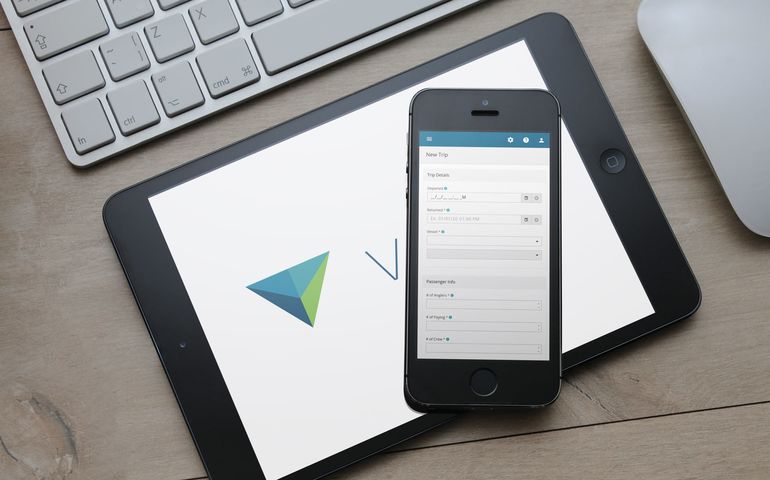Processing Your Payment
Please do not leave this page until complete. This can take a few moments.
- News
-
Editions
View Digital Editions
Biweekly Issues
- December 15, 2025
- December 1, 2025
- Nov. 17, 2025
- November 03, 2025
- October 20, 2025
- October 6, 2025
- + More
Special Editions
- Lists
- Viewpoints
-
Our Events
Event Info
Award Honorees
- Calendar
- Biz Marketplace
Counting Maine lobsters? There’s an app for that
 Courtesy / Bluefin Data Facebook
The state will provide the lobster industry with a free digital app developed by Bluefin Data to measure the lobster harvest.
Courtesy / Bluefin Data Facebook
The state will provide the lobster industry with a free digital app developed by Bluefin Data to measure the lobster harvest.
A new digital app that maps lobster fishing activity is expected to help the industry manage interactions with two other users of the ocean — the endangered North Atlantic right whale and the burgeoning offshore wind industry.
Developed by Louisiana technology company Bluefin Data under a contract with the Maine Department of Marine Resources, the app, called VESL, is the result of a required increase in the percentage of lobster harvesters who must submit reports.
The app is being provided for free to commercial fishermen and is meant to simplify required harvest reporting for both state and federally licensed fishermen, according to a news release. The required reporting includes location of fishing activity and pounds landed.
"We decided to develop a new app to make it easier for lobstermen to comply with the new reporting requirement," the department’s commissioner, Patrick Keliher, said in the release.
"Better data about fishing activity will help managers sustain Maine's important marine resources and will help ensure informed decisions are made around issues that impact fishermen like whale regulations and offshore wind development."
Founded in 2006, Bluefin Data is a developer of a marine data platform intended to streamline the collection and sharing of reporting data within the seafood industry.
From 10% to 100% reporting
Currently, only 10% of state-licensed lobster harvesters in Maine must report their harvest.
However, as part of an update to a fishery management plan for lobster developed by the Atlantic States Marine Fisheries Commission — a commission of states formed to coordinate and manage fishery resource — 100% of state licensed commercial lobstermen will have to report their harvest information, including location of fishing activity and pounds landed.
The reporting requirement, scheduled for implementation in Maine in 2023, is intended to provide regulators and researchers with more detail about where fishing activity takes place.
The 100% reporting requirement was part of a suite of measures submitted to federal regulators by the department in early 2020, in response to pressure to reduce the presumed risk of an entanglement by North Atlantic right whales in lobster gear from occurring and to minimize the potential of serious injury and mortality in the rare event an entanglement occurs.
Other measures included reduction the number of vertical rope in the water, inclusion of “weak” points in the rope to allow an entangled whale to break free, Maine-specific gear marks to help managers more accurately determine the origin of gear involved in entanglement and develop more targeted protection measures, and an allowance for individual areas to implement equivalent conservation measures.
Simplified reporting
A request for proposals issued by the department required developers to not only produce an app that would work for lobstermen, but also for other state and federal fisheries that require harvester reports.
The department’s landings program manager, Rob Watts, worked with the developer.
"We wanted a product that would simplify the task of reporting for fishermen and provide the data regulators and researchers need to more effectively manage, monitor and sustain our commercial fisheries,” Watts said.
VESL personalizes the interface, depending on the requirements of the fishery. For example, fields required will be customized based on the license, permits and gear type used.
Data can be entered while at sea and uploaded when an internet connection is established, designed to make submission of reports easy.
"This app was developed with fisherman input. It is easy to use, and allows harvesters to file reports quickly and efficiently," said Keliher. "Our goal with this product was to develop something that reduces the burden of reporting and lets fishermen focus on catching fish."
VESL is compatible with mobile devices and will work across multiple platforms. The app was approved by the National Oceanic and Atmospheric Administration for use by federally permitted harvesters.
Even in a historically tough year, Maine's lobster fishery in 2020 once again accounted for most of the state's overall fisheries landed value, with the lobster catch totaling $405.98 million.
Mainebiz web partners

The Giving Guide
The Giving Guide helps nonprofits have the opportunity to showcase and differentiate their organizations so that businesses better understand how they can contribute to a nonprofit’s mission and work.
Learn More
Work for ME
Work for ME is a workforce development tool to help Maine’s employers target Maine’s emerging workforce. Work for ME highlights each industry, its impact on Maine’s economy, the jobs available to entry-level workers, the training and education needed to get a career started.
Learn More
Groundbreaking Maine
Whether you’re a developer, financer, architect, or industry enthusiast, Groundbreaking Maine is crafted to be your go-to source for valuable insights in Maine’s real estate and construction community.
Learn more-
The Giving Guide
The Giving Guide helps nonprofits have the opportunity to showcase and differentiate their organizations so that businesses better understand how they can contribute to a nonprofit’s mission and work.
-
Work for ME
Work for ME is a workforce development tool to help Maine’s employers target Maine’s emerging workforce. Work for ME highlights each industry, its impact on Maine’s economy, the jobs available to entry-level workers, the training and education needed to get a career started.
-
Groundbreaking Maine
Whether you’re a developer, financer, architect, or industry enthusiast, Groundbreaking Maine is crafted to be your go-to source for valuable insights in Maine’s real estate and construction community.
ABOUT
NEW ENGLAND BUSINESS MEDIA SITES
No articles left
Get access now
In order to use this feature, we need some information from you. You can also login or register for a free account.
By clicking submit you are agreeing to our cookie usage and Privacy Policy
Already have an account? Login
Already have an account? Login
Want to create an account? Register
Get access now
In order to use this feature, we need some information from you. You can also login or register for a free account.
By clicking submit you are agreeing to our cookie usage and Privacy Policy
Already have an account? Login
Already have an account? Login
Want to create an account? Register







0 Comments